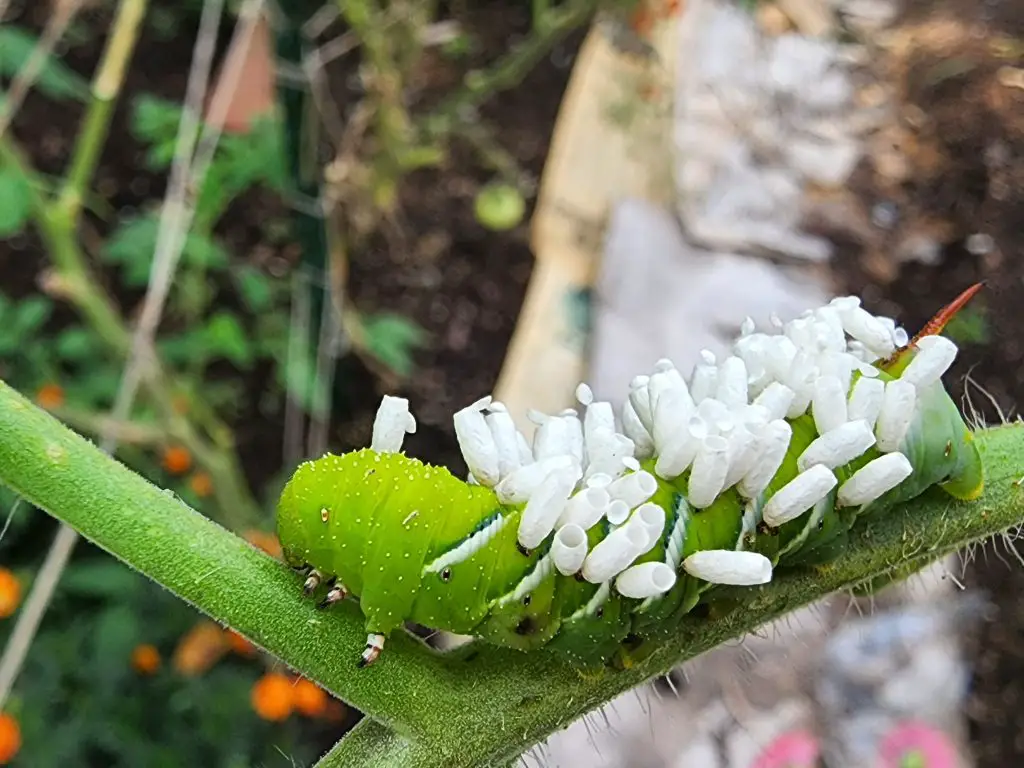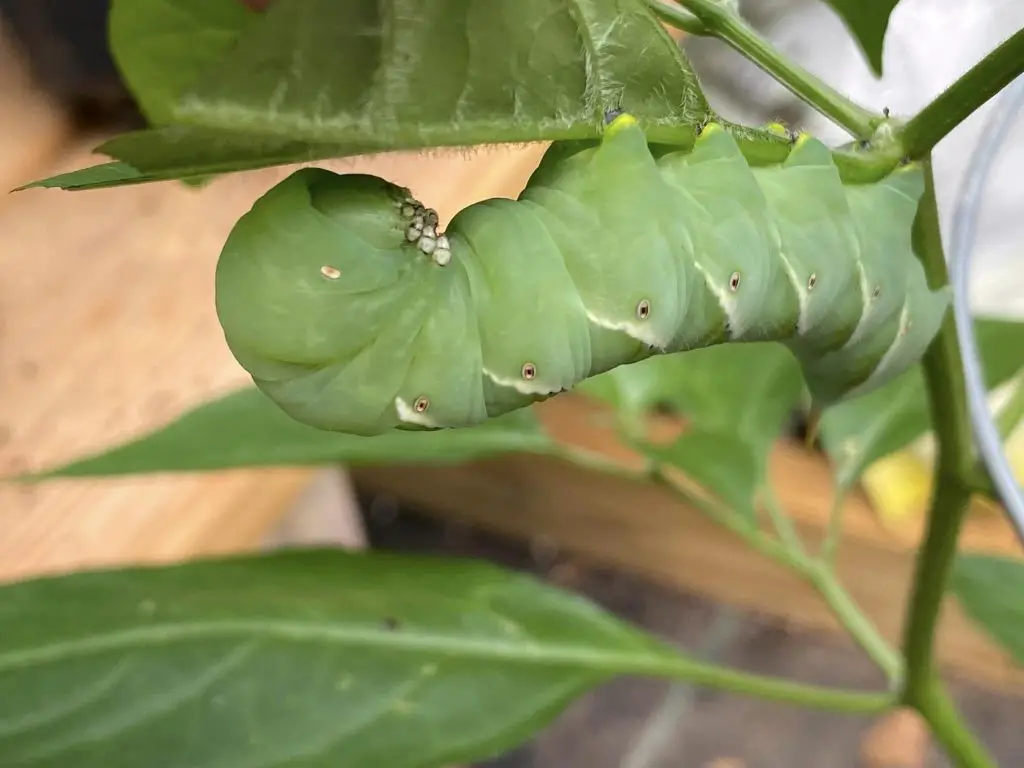When under a black light, tomato hornworms do indeed glow in the dark. And their cool ability to glow is what gives you the advantage over them in the garden!
Tomato hornworms are a gardener’s worst nightmare, and there’s no way of avoiding them. As a matter of fact, I pulled a hornworm off of my healthiest tomato plant yesterday.
I couldn’t believe my eyes! In a single night, this gluttonous green grub had mowed down an entire foot of lush foliage! The devastation these creatures can inflict is not for the faint of heart. But lucky for us, their strange luminescence is the secret to turning the tide in our favor. Let’s dive into this curious phenomenon and how it can actually be harnessed to protect our precious tomato plants from these midnight marauders.
Why Tomato Hornworms Glow In The Dark
Bioluminescent Properties
Tomato hornworms are fascinating creatures, and many a gardener has wandered into the garden at night armed with a black light flashlight to find these little pests that blend in so easily during the day. This glowing phenomenon is most likely due to the presence of bioluminescent bacteria on their skin. Bioluminescence is the natural emission of light by living organisms, similar to how fireflies light up. It’s a captivating phenomenon observed in creatures like fish, shells, and insects.
When exploring your garden, you might notice that tomato hornworms have an unusual and mesmerizing appearance. But don’t be alarmed! These caterpillars are not harmful to humans, and their horn-like projection isn’t even sharp enough to pierce the skin.
Effect of UV Light
Although tomato hornworms may not emit light on their own, they do have a unique feature under UV light. Using a UV blacklight, such as a black light flashlight, can make hornworms fluoresce, allowing you to spot and manage them more easily in your garden. This method also benefits the environment, as no chemicals are necessary, just a pair of gardening gloves and a bucket of soapy water (or your backyard chickens if you have them).

With the help of a UV light, these large caterpillars glow neon, similar to how some fish scales and shells can shine under UV light. The use of this wavelength helps you monitor and control these pests, ensuring the health and success of your tomato plants.
Identifying and Locating Tomato Hornworms
Physical Characteristics
Tomato hornworms are infamous for their devastating impact on tomato plants and other members of the nightshade family, like potatoes. These large caterpillars have green bodies with parallel white stripes and white V-shaped markings, which help them camouflage against the foliage. Their most distinctive feature is the horn-like projection on their tail end, which may be black or red, depending on the species.
Nighttime Hunting
Since hornworms glow in the dark under a black light, nighttime hunting is your best defense. Once the sun goes down, head out into your garden equipped with a blacklight and begin the hunt. The green bodies of the hornworms will emit a faint glow under the blacklight, making it easier for you to spot them amongst the foliage.
Once you’ve identified the tomato hornworms, gently remove them from your plants and either place them in a bucket of soapy water or feed them to your chickens if you have them (chickens find them to be a tasty treat). Remember to always monitor your garden for these pesky critters, because they can cause serious damage to an otherwise healthy plant overnight.
Life Cycle and Biology
Tomato hornworms, also known as Manduca quinquemaculata, have a fascinating life cycle. In this section, we will explore the four primary stages of their development: Egg Stage, Larval Stage, Pupal Stage, and Adult Stage.
Egg Stage
The life cycle of the tomato hornworm begins with the egg stage. The eggs are typically a pearly pale green to greenish-yellow color and measure less than 0.039 inches. Female adult hawkmoths, also known as sphinx moths, lay these eggs on the underside of leaves of tomato and other nightshade family plants. Keep an eye out for these eggs, as they will soon hatch into hungry little caterpillars.
Larval Stage
Once the eggs hatch, the larval stage begins. This stage is when you’ll encounter the large, green caterpillars with a horn-like tail. These caterpillars are the larvae of the Manduca quinquemaculata or Manduca sexta species. Their favorite plants to munch on are tomatoes, but they also feed on members of the nightshade family, such as peppers, potatoes, and eggplants. The larval stage is when most of the damage to your plants occurs, so it’s essential to take action and remove them if you spot them in your garden.
Pupal Stage
After the caterpillar larvae have eaten their fill, they will enter the pupal stage. During this stage, the caterpillars will drop into the soil and create a cozy underground chamber where they will transform into their adult form. The pupal state is a crucial period for tomato hornworms, where they undergo significant change and are relatively inactive. While they are in this stage, it’s challenging to spot and improve any damage done to your plants.
Adult Stage
Finally, the adult worm, which is actually a hawk moth or sphinx moth, emerges from the pupal stage. These moths are impressive pollinators, helping your garden plants to thrive. However, remember that adult female moths will lay eggs, leading to a new generation of tomato-devouring caterpillars. So it’s essential to keep an eye out for them and their eggs to manage any potential damage to your garden.
Damage and Impact on Plants
Defoliation Effects
Tomato hornworms can cause extensive damage to your tomato plants, as well as other plants in the nightshade family, such as eggplants, peppers, and potatoes. These pests have a voracious appetite and can devour large sections of leaves and flowers, leading to significant defoliation. This defoliation reduces the foliage cover and can expose the fruit to direct sunlight, increasing the risk of sunscald. The damage caused by hornworms can sometimes go unnoticed because the caterpillars blend in well with the leaves, hiding in plain sight.
Crop Losses
Aside from defoliation, tomato hornworm infestations can result in direct damage to your tomato crop. They can create scarring on fruit surfaces, affecting their aesthetic appearance and potentially leading to other insects moving in to feast on the fruit.
To minimize the impact of hornworms on your garden, it is crucial to frequently inspect your tomato plants for signs of damage and take appropriate measures to address it. Some effective control methods include handpicking hornworms, introducing natural predators, or using organic pesticides.
By being vigilant and proactive, you can mitigate the damage caused by tomato hornworms and protect your garden and tomato plants from these voracious pests. Keep your eye out for their distinctive gray-brown cocoons and the telltale defoliation that accompanies hornworm activity.
Natural Control Methods
Parasitic Wasps
One effective way of controlling tomato hornworms is by attracting parasitic wasps. There are several varieties, such as braconid wasps, that prey on hornworms. These small but mighty insects lay their eggs inside the hornworms, and once the larvae hatch, they feed on the hornworm, eventually killing it. You can help attract parasitic wasps to your garden by planting flowers like buckwheat, which serves as a food source for the adult wasps.

Predators and Beneficial Insects
Another natural method to keep hornworms at bay is by encouraging the presence of their natural predators and other beneficial insects. Chickens, for instance, are excellent at controlling hornworm populations as they love to snack on these pests. In addition, ladybugs and lacewings, particularly green lacewings, are known to feed on hornworm eggs and larvae. Introducing these helpful predators into your garden is a great way to keep hornworm numbers under control.
Companion Planting
Companion planting is another useful strategy for managing tomato hornworms. By interplanting various plants, you can create an environment that is less appealing to the hornworms. For example, planting marigolds and basil near your tomatoes can help deter hornworms from laying their eggs on your plants. Additionally, interplanting with other crops, such as onions, can create a more diverse garden ecosystem that makes it harder for hornworms to thrive.
By using these natural control methods, you can help to protect your tomato plants from the damage caused by hornworms, while reducing the need for chemicals in your garden.
Distinguishing Between Tomato and Tobacco Hornworms
Color Patterns
When identifying hornworms in your garden, you could be looking at either a tomato hornworm or a tobacco hornworm. The tobacco hornworm has white stripes with black margins and boasts a red horn, whereas the tomato hornworm has green margins on its white stripes and a blue horn. In addition, tobacco hornworm larvae have 7 diagonal stripes on each side and a red posterior horn. In contrast, tomato hornworm larvae feature 8 chevrons on each side and a bluish-black horn. Their adult moths also differ in appearance: tobacco hornworm moths have six orange spots on their abdomen, while tomato hornworm moths have five.
Host Plants
Both tomato and tobacco hornworms are found in various host plants within the nightshade family, including tomatoes, tobacco, potatoes, and peppers. As their names indicate, tobacco hornworms readily feed on tobacco plants. At the same time, tomato hornworms are known for their appetite for tomato plants. These voracious caterpillars may also feast on ANY other plants in the nightshade family, so it’s crucial to keep an eye out for signs of infestation.
Prevention and Treatment Measures
Taking appropriate prevention and treatment measures can help protect your tomato plants from hornworms. Here are a few methods you can use to keep these pests under control.
Handpicking
As a gardener, handpicking is often the most effective method to remove hornworms from your tomato plants. Check your plants regularly, especially in the mornings and evenings when these insects are more active. Wear gloves for extra protection while handpicking and disposing of the hornworms. It might be helpful to have a container of soapy water handy, so you can drop the hornworms directly into the water after you find them.
Organic Pesticides
There are several organic pesticides you could use to control hornworms in your garden:
- Bacillus thuringiensis (Bt): This naturally occurring soil bacterium can be used as a spray to effectively control hornworms. Once ingested by the hornworm, Bt releases toxins that cause the insect to stop eating and eventually die. To achieve the best results, apply Bt when you first notice hornworm damage or presence.
- Spinosad: This organic pesticide is derived from a naturally occurring soil bacterium and is highly effective against tomato hornworms. Mix the spinosad with water according to the product’s label instructions, and then spray it on your tomato plants, focusing on the leaves where hornworms feed.
- Insecticidal Soap: Mixing soapy water or using a commercial insecticidal soap can help you spot hornworms hiding among the foliage and make them easier to handpick. Spray the solution on your tomato plants, and then inspect the leaves for any hornworms that might have been dislodged or are more visible due to the soap.
When using any organic pesticide, make sure to follow the product’s label instructions and apply it in appropriate quantities.
Further Tips for Dealing with Hornworms
Cultivating a Healthy Garden
A healthy garden is essential for combating tomato hornworms. This begins with planting a variety of plants that attract beneficial insects, like parasitic wasps, who help keep hornworm populations under control. In addition to tomatoes, consider growing eggplants, peppers, and other solanaceous plants, as these can also deter hornworms.
To further discourage hornworms from settling into your garden, it’s important to practice good horticulture. Rotate your crops each growing season to prevent pests from becoming too comfortable in their environment. Using a combination of organic pesticides and biological control methods, such as encouraging birds, will also help.
Monitoring Activities
Regular monitoring is crucial for dealing with tomato hornworms. During the growing season, inspect your plants for frass, a clear sign of hornworm activity. The color and size of caterpillars can often blend in with the plant material, but using a UV flashlight and goggles will make them stand out.
Tomato hornworms are known to be more active during the night, so grab your UV flashlight and do a quick scan of your garden when it’s dark. Their glowing appearance under UV light makes it easier to spot and remove them from your plants.
Frequently Asked Questions
What makes hornworms visible under UV light?
Tomato hornworms become visible under UV light because their body absorbs ultraviolet light and re-emits it as visible light, causing them to appear almost fluorescent or glowing green. This phenomenon helps you spot these pests in your garden more easily during nighttime.
How do I find tomato hornworms with a blacklight?
To find tomato hornworms using a blacklight, simply shine the UV flashlight onto your tomato plants during nighttime. The hornworms will glow green, making them easier to spot and remove from your plants. Some gardeners have found success in using UV flashlights for this purpose.
Are there other insects that glow under UV lights?
Yes, many other insects besides tomato hornworms will also glow under UV lights. For example, scorpions, millipedes, and some species of spiders also exhibit fluorescence when exposed to ultraviolet light.
What stage of tomato hornworms’ life glows the most?
All stages of tomato hornworms will glow under UV light; however, the caterpillar stage tends to be the easiest to spot because of its larger size and more apparent feeding damage on the plants.
How does a UV flashlight help in detecting tomato hornworms?
A UV flashlight helps in detecting tomato hornworms by causing them to glow green under the ultraviolet light. This glowing effect makes the hornworms stand out against the foliage, allowing you to easily spot and remove them from your plants.
Is there a specific time to use Blacklight to find hornworms?
The best time to use a blacklight to find hornworms is during nighttime when it’s dark, as the glowing effect will be more visible. This can be especially helpful during the early morning or late evening hours when the pests may be more active and feeding on your plants.
Final Thoughts
The illuminating phenomenon of the glowing tomato hornworms is not just an eerie spectacle, but also a powerful tool in our gardening arsenal. Nighttime hunting with a trusty blacklight not only offers an almost magical experience for children but also gives us an upper hand in our eternal struggle against these gluttonous pests.
The fight against these resilient creatures might seem daunting, but rest assured, with consistent vigilance, and a touch of blacklight mystery, you’ll ensure a thriving, hornworm-free tomato harvest. Happy hunting!

